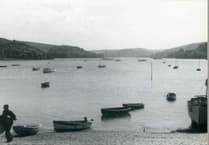The Kingsbridge and District branch of the Royal British Legion held a commemoration of the Second Battle of El Alemein.
Members of the legion, Kingsbridge Town Council and members of the public came together at the War Memorial on Embankment Road in Kingsbridge on Friday, October 20. A short service was conducted by the Rev Jackie Taylor and a wreath laid by Leon Lock, Kingsbridge RBL chair. Branch President Ken Court read the Exhortation.
The Second Battle of El Alemein took place between October 23 and November 4, 1942, around the Egyptian town 100km west of Alexandria.
According to the BBC History website, although General Claude Auchinleck had stopped Rommel in his tracks during the First Battle of El Alamein in early July 1942, Churchill was becoming increasingly impatient with progress in the Western Desert.
In early August that year, he arrived in Cairo and handed over command to General Bernard Montgomery. Auchinleck left for India.
Montgomery restructured the 8th Army, bringing in new divisions and generals and lifting the army’s morale with his bold fighting talk - declaring among other things that he would “hit Rommel for six out of Africa”.
Rommel attempted an attack between August 30 and September 7 (the battle of Alam Halfa), but the 8th Army held its ground, largely due to the excellent cooperation between the army and the air force. Montgomery did not make a counter-attack - he knew that reinforcements were on their way and he was biding his time.
Montgomery planned his attack in two phases. The first, Operation Lightfoot, would consist of a powerful artillery bombardment followed by an attack by the infantry divisions of 30th Corps in the north, and 13th Corps in the south. They would open paths in the minefield through which the armoured divisions of 10th Corps would pass.
On October 25, Rommel returned from Germany to take command, after Von Stumme died of a heart attack during battle.
On the night of November 1, Montgomery launched the second phase of his attack, Operation Supercharge, which was designed to break through the last part of the German defences. The infantry units cleared the way for the armoured divisions, and Rommel, his army depleted and his petrol almost finished, decided the battle was lost.
Hitler ordered Rommel to “stand and die”, but the Panzerarmee had already begun to retreat by the time the order was received. At midday on November 4, Rommel’s last defences caved in and that evening he received orders from Hitler to withdraw.
The Second Battle of El Alamein was a turning point in the North African campaign. It ended the long fight for the Western Desert, and was the only great land battle won by the British and Commonwealth forces without direct American participation. The victory also persuaded the French to start cooperating in the North African campaign.
By the time the battle had ended, 9,000 German and Italian soldiers were killed or missing, 15,000 were wounded, and 35,000 had been taken prisoner. On the Allied side, 4,810 men were killed or missing, with 8,950 wounded.





Comments
This article has no comments yet. Be the first to leave a comment.